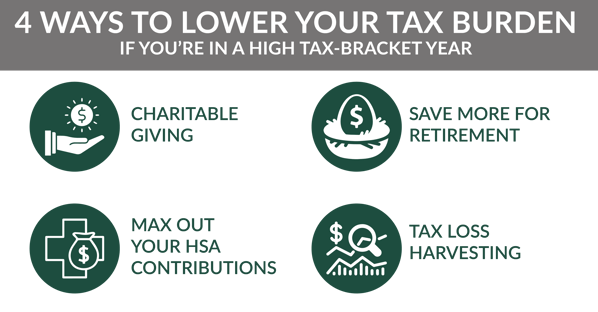It's an old adage, but one that especially rings true as we gear up for tax season: if you fail to plan, you plan to fail.
Tax planning is a crucial component of any comprehensive financial plan and plays a significant role in wealth accumulation over time. There are a few strategies that we've used with our clients to help reduce their tax burden and increase their savings over the years, helping them pursue their financial goals. You don’t want to miss these simple tax planning opportunities since each one can have a huge impact on your taxes. Let's dive in.
Determining Your 2025 Tax Bracket is the Key to Good Tax Planning
Start with identifying your sources of taxable income and any deductions you qualify for to reduce this income. It’s also helpful at this stage to project your taxable income for the upcoming year, especially if you’re expecting any big changes, like retirement
2025 Tax Brackets |
||||
| Tax Rate | Single | Married Filing Jointly | Married Filing Separately | Head of Household |
| 10% | Up to $11,925 | Up to $23,850 |
Up to $11,925 |
Up to $17,000 |
| 12% | $11,926 - $48,475 | $22,851 - $96,950 |
$11,926 - $48,475 |
$17,001 - $64,850 |
| 22% | $48,476 - $103,350 | $96,951 - $206,700 |
$48,476 - $103,350 |
$64,851 - $103,350 |
| 24% | $103,351 - $197,300 | $206,701 - $394,600 |
$103,351 - $197,300 |
$103,351 - $197,300 |
| 32% | $197,301 - $250,525 |
$394,600 - $501,050 |
$197,301 - $250,525 |
$197,301 - $250,500 |
| 35% | $250,526 - $626,350 |
$501,051 -$751,600 |
$250,526 - $375,800 |
$250,501 - $626,350 |
| 37% | $626,351 or more | $751,601 or more | $375,801 or more | $626,351 or more |
2025 Standard Deduction Amounts |
||||
|
Year |
Single |
Married Filing Jointly or Surviving Spouses |
Married Filing Separately |
Head of Household |
|
2024 |
$14,600 |
$29,200 |
$14,600 |
$21,900 |
|
2025 |
$15,000 |
$30,000 |
$15,000 |
$22,500 |
Understanding which tax bracket you fall into can be helpful when trying to determine the best strategies to pursue to get tax savings.
6 Strategies to Lower Your Tax Burden
If you’re in a high tax bracket this year, you can try:
Charitable Giving Options
There are many ways to give to charity depending on your circumstances. And if you currently take the standard deduction, these techniques can put you in the position of itemizing your deductions.
- Give to the charity outright. Whether you’d prefer to write a check or swipe your credit card, giving to your charity(-ies) of choice in 2025 can yield tax benefits for you as you recover from paying for all the holiday gifts. Additionally, you can “bunch” your charitable contributions into every other year. This permits you to take advantage of the increased standard deduction ($30,000 for 2025 married filing jointly) every other year while itemizing the contributions in other years.
- Qualified Charitable Distributions (QCD). If you are age 70 ½ or older and receive Required Minimum Distributions (RMD) from your retirement savings, you can designate an RMD to be distributed directly to a charity. This is called a Qualified Charitable Distribution. This QCD will not be included in your taxable income, and it will also meet your RMD requirements. As a bonus, this is a charitable giving strategy that saves tax regardless of whether you itemize or take the standard deduction.
-
Donor Advised Fund (DAF). You can make a large one-time donation to a DAF and receive a charitable deduction for the year the donation was made. Additionally, you control when the money is distributed to a charity.
For example, if you contribute $100,000 to a DAF, you can receive the deduction on your tax return for the year of the contribution. You can then designate a charity to receive $10,000 per year for 10 years. Moreover, the earnings that accrue while invested in a DAF are not taxed.
-
Donate Low-Basis Stock to Charity. Do you have a stock that has increased significantly in value, and you are in a high ordinary and capital gains tax bracket? You can donate this stock to charity, whether directly or through a DAF. The gain will be transferred to the charity, which is exempt from taxation. Additionally, you receive a charitable deduction for the value of the stock, which is a total win-win.
Maximizing Your Retirement Plan Contributions
If you’re still working and not contributing the maximum amount to your 401(K), you are missing out on a significant tax savings opportunity – both immediately and long-term. Pre-tax contributions are made to a 401(k), resulting in lower taxable income each year. For 2025, the maximum contribution is $23,500, with an additional $7,500 “catch-up” contribution if you are 50 to 59 years old, and $11,250 if you are 60 to 63 years old. To ensure you’re maxing out your contributions, log into your company’s benefits website and review your contribution amount.
Make sure you don't make this common 401(k) mistake and miss out on contributions >>
Maxing Out Your Health Savings Account (HSA) Contribution
If your company offers a Health Savings Account (HSA), be sure you’re contributing the maximum amount to it. Similar to 401(K) contributions, HSA contributions can be deducted from your taxable income and can potentially get you into a lower tax bracket. The HSA contribution limit for 2025 is $4,300 for individuals and $8,550 for families. If you’re 55 or older, you can contribute an additional $1,000 catch-up for a total of $5,300 for individuals and $9,550 for families. HSA accounts are only available to individuals covered by a high-deductible healthcare plan.
Tax Loss Harvesting
If you have an investment that has lost value since your purchase, sell it and use the loss to offset gains you’ve made from sales earlier in the year. Similarly, you can use the loss to offset a gain from an investment you want to sell.
Learn More About the Tax Loss Harvesting Investment Strategy Here >>

If you’re in a lower tax bracket this year, you can try:
The next two items on our list are for taxpayers who find themselves in a low tax bracket year. For example, years after retirement or a year when there is a large business loss.
Roth Conversions
If you have a traditional IRA, you can convert that IRA (or the after-tax portion of that IRA, depending on the type of IRA you possess) to a Roth IRA using a Roth Conversion. A Roth has the advantage that, since contributions are made after-tax, all earnings are distributed tax-free, and there are no Required Minimum Distributions at age 73. The downside is that all the tax is due at the time of conversion. Therefore, if circumstances are such that you are in a low-income year, you can convert to a Roth and pay the tax at a low tax bracket.
Stepping Up Basis in a Stock
If you have a low-basis stock that has appreciated substantially, you can sell that stock and recognize the gain as taxable income. Because you are in a low-income year, your capital gains tax rate will also be low (and could be as low as 0%). If you truly like this stock, you can sell it and then immediately repurchase it. This essentially “steps up” the basis by recognizing the gain in a low-income year and repurchasing at a higher cost.
How Will You Lower Your Tax Burden This Year?
Correctly assessing and projecting your income can have significant impacts on your tax planning and overall financial plan. Our advisors at Willis Johnson & Associates are hard at work ensuring that clients receive outstanding tax planning and financial services. To get started on pursuing your financial goals, start the conversation with our wealth advisors and CPA to see what opportunities and tax savings our team can uncover for you.







